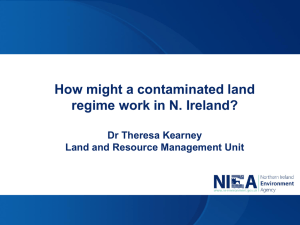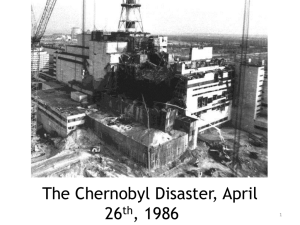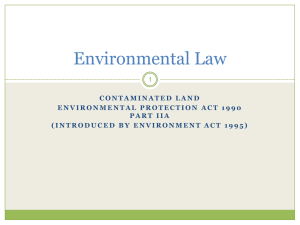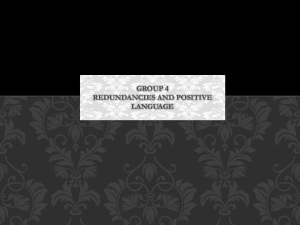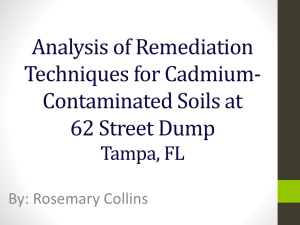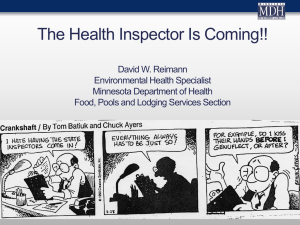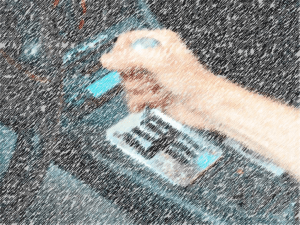Contaminated Land Management Framework in Malaysia
advertisement
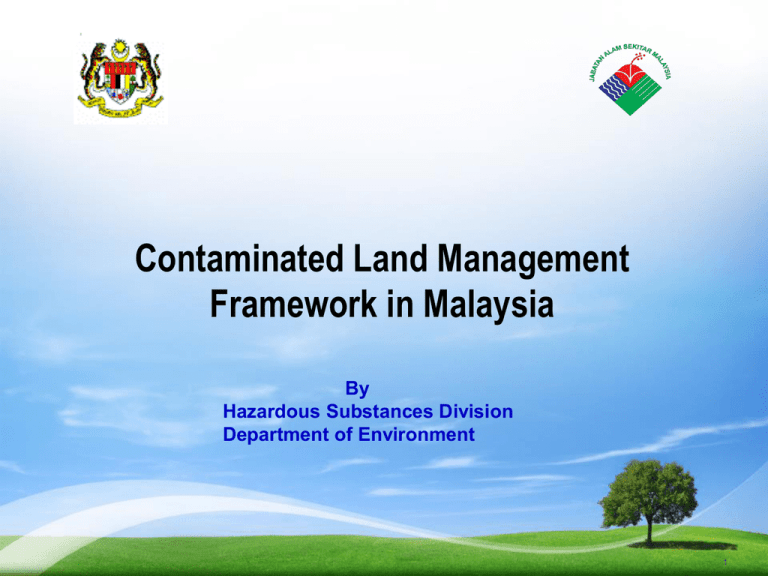
Contaminated Land Management Framework in Malaysia By Hazardous Substances Division Department of Environment 1 BACKGROUND Many industrial sites can be potential contaminated sites as a result of industrial development over the past 25 years. Contaminated land can be found at many places such as motor workshops, petrol stations, fuel depots, railway yards, landfills, industrial sites and ex-mining land No specific legislation addressing soil and groundwater contamination in Malaysia No soil or groundwater quality standards Little work carried out in identifying contaminated sites Soil Quality is not monitored Contaminated land is slowly gaining importance 2 IS SOIL POLLUTION CONTROL BY ENVIRONMENTAL QUALITY ACT 1974? Section 24 of the Environmental Quality Act 1974 states that; (1) No person shall, unless licensed, pollute or cause or permit to be polluted any soil or surface of any land in contravention of the acceptable conditions specified under section 21. (2) a person shall be deemed to pollute any soil or surface of any land if – (a) he places in or on any soil any matter whether liquid, solid, or gaseous; or 3 IS SOIL POLLUTION CONTROL BY ENVIRONMENTAL QUALITY ACT 1974? (b) he establishes on any land a refuse dump, garbage pit, soil and rock disposal site, sludge deposit site, waste injection well or otherwise used land for the disposal of or a repository for solid or liquid wastes PENALTY (3) fine not exceeding one hundred thousand ringgit or to imprisonment for a period of not exceeding five years or both and to a further fine not exceeding one thousand ringgit a day for every day that the offence is continued after a notice by the Director General requiring him to cease the act specified therein has been served upon him. 4 Ninth Malaysia Plan study on criteria and standard for managing and restoring contaminated land in Malaysia by DOE Purpose of the study to provide a framework for the proper assessment and management of contaminated sites that would ensure a consistent standard of site assessment and subsequent management is implemented at all contaminated sites to provide some guidance to those responsible for management and assurance to the community that public health and environmental concerns on contaminated sites are being addressed. Toxic & Hazardous Waste Storage Industrial Area 5 WHAT IS CONTAMINATED LAND? Contaminated Land means a site at which a substance occur in, on or under the land at concentration: Above the concentration at which the substance is normally present in or on the land in the same locality and pose or are likely to pose an immediate or long term hazard to human health or the environment; or Exceed concentration specified in the Site Screening Levels (SSLs). Toxic & Hazardous Waste Storage Industrial Area 6 Overview of Contaminated Land Management Framework in Malaysia SCOPE OF APPLICATION Framework applies to:- 1. Any land that are currently being used or were previously used, to perform potential polluting activities Polluting activities define as any activities involving manufacture, store, use, handle and dispose of chemicals and hazardous waste. Industries with the potential of contaminating soil and groundwater. 2. Any land that will involve in a change of land use from polluting activities to non polluting activities 7 GENERAL GUIDING PRINCIPLES 1. Polluter Pay Principle Define the responsibility for performing a site assessment and remediation. Polluter can be the land owner or land occupier or any polluter of any land. 2. Risk-Based Approach Highlights potential current and future risk associated with the presence of contaminants in the soil and groundwater matrix. recommended corrective actions to mitigate or control incremental risk to the level acceptable from the human health and ecological perspectives. 8 LAND CATEGORIES 1. Land with identified responsible party Contaminated land will require site assessment and remediation in accordance with the three guidelines proposed by Department of Environment (DOE). 2. Land with no identified responsible party/Excluded Land Contamination that is not possible for clean up under the current conditions due to technology and resource availability is economically not feasible to be assessed and remediated under the contaminated land management (CLM) framework due to the scale of economic impact on the country; Applies for only agricultural land, municipal domestic waste landfill, former mining land and orphan land; and Requires a proposed risk management plan. 9 POLLUTER’S RESPONSIBILITY Determine if there is any contamination in their land. presence of subsurface Notify DOE on any subsurface contamination Determine if there is any unacceptable human health and ecological risk. Propose a remediation action plan (RAP), implement, construct, operate and maintain appropriate remediation actions in order to address the risk arises from the presence of the identified subsurface contamination. 10 Responsibility on Category 2 Contaminated Land For land properties categorized under Category 2, the government authorities who have the direct jurisdiction on the land will be the custodian who should perform all actions required under the contaminated land management framework. The responsible authorities should ensure sufficient resources are planned and allocated in the undertaking of those actions until the land is cleaned up and safe for its designated future land uses. 11 SITE SCREENING LEVELS (SSLs) Prescribed in the ‘Contaminated Land Management and Control Guidelines No. 1: Malaysian Recommended Site Screening Levels for Contaminated Land’ US EPA Regional Screening Levels has been referred in developing the Site Screening Levels (SSLs) Exceeding SSLs indicates potential subsurface contamination SSLs are not the national cleanup standards, it is use in the process of identifying and defining areas, contaminants, and conditions at a particular site. 12 SITE SCREENING LEVELS (SSLs) Sites with contaminants concentrations exceeding the SSLs will be considered as “contaminated land” - further assessment will be required to determine any health risk or ecological effects Risk assessment shall be conducted to define an appropriate site-specific clean up target levels. As SSL are derived based on conservative assumptions that overestimate the human and ecological risk in most cases, cleaning up to achieve SSL is considered acceptable if the responsible party choose to achieve the proposed SSL without developing the site specific target level. 13 Site Specific Target Levels • In the event if site clean up is required, the responsible person(s) shall justify the Site-Specific Target Levels (SSTL) that are protective of human health and ecological well being. 14 SITE SCREENING LEVELS (SSLs) 15 SITE INVESTIGATION & ASSESSMENT Prescribed in the ‘Contaminated Land Management and Control Guidelines No. 2: Assessing and Reporting Contaminated Sites’ Site assessment activities, i.e.: Initial Assessment (or Phase I ESA) Detailed Assessment (or Phase II ESA) Risk Assessment 16 SITE ASSESSMENT ACTIVITIES Initial Assessment (Phase I ESA) Historical Site Survey/desk top study ‘Walkover’ Assessment (site visits) to identify hazards, receptors etc Formulation of initial Conceptual Site Model (CSM) (preferably diagrammatic for clarity) Detailed Assessment (Phase II ESA) Carried out after Phase 1 ESA when findings has shown that land is potentially impacted by onsite or offsite activities Intrusive sampling (boreholes, trenches, sampling) Chemical analysis of contaminants Further refinement of CSM 17 CONCEPTUAL SITE MODEL (CSM) Transport Source Receptor Example: Example: Example: 1. UST leakage 1. Leaching to soil & groundwater 1. Human 2. Tanker accident 3. Container spillage 2. Dispersed by wind 2. Ecology 3. Flora & fauna 3. Flow into surface water 18 SITE ASSESSMENT ACTIVITIES Risk Assessment Land properties which are detected with subsurface contamination at concentrations higher than the Site Screening Levels (SSL) Process of estimating potential impact of contaminant on ecosystem or human population under a specific set of conditions Allows most significant risks to be identified and addressed and the more significant pathways to be identified, facilitating effective targeting of risk mitigation strategies 19 BASELINE ENVIRONMENTAL SITE ASSESSMENT (BESA) For land properties which are not identified with any potential subsurface contamination during the initial assessment, it is recommended to conduct minimum baseline environmental site assessment to establish the background level of subsurface soil and groundwater quality for future reference, this is especially applicable for land properties that will be used for activities of polluting industries. 20 REMEDIATION Remediation processes would apply for the following scenarios: Site(s) with soil and groundwater concentration detected above the SSLs Site(s) that are concluded to pose unacceptable risk to human health based on the findings of human health risk assessment performed in accordance with the ‘Contaminated Land Management and Control Guidelines No. 2: Assessing and Reporting Contaminated Sites’ 21 CONTAMINATED LAND CLOSURE REPORT Submit the Closure Report to DOE, consists of: Objective - to summarize project information into a single, succinct, summary report Documents what was planned, what was actually completed and what remains outstanding Identifies any post-remediation requirements for the site: o Long-term monitoring o Risk management features o Permanent site features that need to be protected and maintained Restrictions to site use 22 CONTAMINATED LAND MANAGEMENT (CLM) FRAMEWORK Yes Ready for typical CLM cycle? Is it an excluded land? No No Yes Remediation & reporting of contaminated sites Assessment and reporting contaminated land Exceed SSLs? Yes Yes Yes Further remediation? Need further assessment? No Implement or incorporate risk control measures Meet clean up goals SSTLs? No Yes No Qualitative Risk Assessment No No Risk control measures needed? Yes Ready for proper closure? No Yes Implement risk control measures Continue with risk control measures No Ready for Closure? Project Closure Yes Contaminated Land Management and Control Guidelines No. 1: Malaysian Recommended Site Screening Levels for Contaminated Land Contaminated Land Management and Control Guidelines No. 2: Assessing and Reporting Contaminated Sites Contaminated Land Management and Control Guidelines No. 3: Remediation of Contaminated Sites 23 QUALIFICATION REQUIREMENTS All consultants or individual involved in the assessment and remediation of the contaminated land management shall fulfill the qualification requirements and registered with the DOE. All consulting firms performing any activities under the contaminated land management framework shall be registered with the DOE. 24 ISSUES FOR FURTHER CONSIDERATION Low level of awareness amongst the public including the professionals CLM Framework to be agreed by other relevant agencies e.g. Land authorities, local government, Minerals and Geoscience Department Capability and Resources needed for implementation of CLM Framework 25 THANK YOU TERIMA KASIH 26
